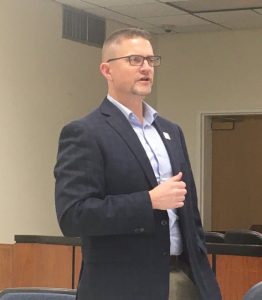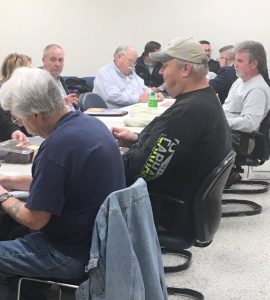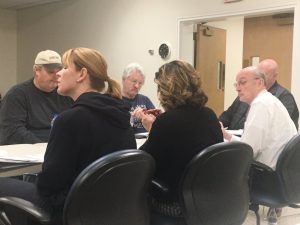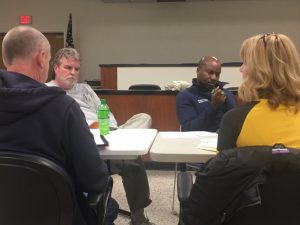February 8, 2020
By: Dwayne Page
How much can the county afford for new school construction and what will be built?
The budget committee and full county commission will soon have to answer those questions.
During an informal work session Thursday night, the budget committee and the Board of Education met jointly to discuss the standing proposal for two new Pre-K to 8 grade schools and converting Northside Elementary to a Pre-K to 8 complex. They also talked about the possibility of funding the board’s original and less expensive plan to build a new Pre-K to 2nd grade school to replace Smithville Elementary School. Some say the Pre-K to 2 plan could be completed quicker and paid off over a shorter period of time which would make starting another project, maybe a new high school, a more realistic goal in the foreseeable future.
According to Upland Design Group, the Board of Education’s architect, the cost of building the Pre-K to 8 schools (capacity of 700 students each) totals at least $48 million versus $30 million for the Pre-K to 2 school (capacity of 900 students)
The budget committee will meet with the county’s financial advisor Steve Bates in the coming days to determine if the county can afford to fund the school board’s current request.
“I want to support the vision that the Board of Education wants to support. I am an education girl but as a commissioner I want to find a way to fund what they want. If we can’t fund it our job as a commission is to figure out what we can do but I want to drive on their vision,” said second district county commissioner Sabrina Farler who is also a member of the county budget committee.
Dennis Slager, first district commissioner and Chairman of the Budget Committee, asked School Board Chairman Danny Parkerson if the Board of Education would be satisfied with the county funding the Pre-K to 2 option if it met immediate school needs.
“It would serve our needs but that is a board decision (whether to revise the request for a Pre-K to 2)”, said Parkerson.
“I leaned toward the Pre-K to 2 to begin with. I am not saying I am against the Pre-K to 8 but as a matter of time, efficiency, taxes, and everything if you are asking if I am amendable to the $30 million (Pre-K to 2 project) my answer is yes,” said School Board member W.J. (Dub) Evins, III.
Although the budget committee has not yet voted on any construction funding, Slager said the county can’t currently afford the Pre-K to 8 plan without a sizeable property tax increase.
“Financially we can only do so much. We don’t have a lot of money and we went into cash (reserves) over $700,000 this year. In my opinion we cannot afford a $48 million building project. It would involve a tax increase and long term financing,” he said.
However, Slager said the county might be able to pay for a Pre-K to 2 school without a tax increase by securing USDA financing with a repayment schedule of 12-15 years.
“This committee will have to decide whether we fund a project we can pay for now and not have to raise taxes or raise taxes and fund a larger request,” he said.
“I think there is a way to fund a Pre-K to 2 by using a portion of school funds without raising property taxes. I will present this to the committee in great detail at a later meeting but USDA offers financing we could pay off at anytime over 12-15 years. As we roll off debt from other bond issues retiring in 2025 and 2029 we can apply that money to this project. This is something we could afford. There are several steps we would have to jump through including getting approved for financing which requires some time but it can all be done in a reasonable period of time. I don’t see why this (school) board and this (county) commission cannot move quickly to resolve this. We are willing to help fund this and move forward,” he continued. “The more information we can get about what we are funding and the amount we are funding then I think this board can move quickly but I truly believe we can finance this without a tax increase over a shorter period of time and get the school system to the next phase of what they want to build,” said Slager.
How to finance the purchase of land, for any building plan, has also become a consideration for the budget committee.
While he is not completely opposed to using a portion of the school districts over $9 million fund balance (reserves) to purchase land for new schools, Director of Schools Patrick Cripps said he wants to make sure there is sufficient money left to fund future local pay raises for teachers from that fund because it is recurring spending.
“Am I opposed to using some of our reserves? No, because it is there. But because of recurring costs in financing local (teacher) pay raises that are coming, if we use our reserve funds to purchase land then the raises would fall back on you (county commission). The Governor in his State of the State speech proposes to give a 4% pay raise across the board for teachers and increase their minimum salaries over time so some of this will be state mandated for BEP teachers with some local obligations for the rest if it is adopted by the state legislature,” said Cripps.
According to Cripps, DeKalb County has about 30 teachers more than required under the Basic Education (BEP) program.
More than two years ago Upland Design estimated construction costs for a Pre-K to 2 school at over $17 million. Updated numbers in November, 2019 put the figure at over $30 million. Fifth district commissioner and budget committee member Jerry Adcock asked why such an increase.
“We had not sat down with Mr. Cripps at that time to determine how big the building needed to be or how many classrooms it needed. We were just using that as a point of reference. The other factor was the cost per square foot was a lot less in 2017 than what it is today for school construction,” said Brian Templeton of Upland Design Group who was at Thursday night’s meeting.
“I also asked the architects to add 20,000 square feet to the original design to allow for growth and more classrooms should the state ever require mandatory pre-K. Also those quotes in 2017 did not include what our engineering fees would be or the costs of furniture and things of that nature. It was just for construction,” added Director Cripps.
Adcock also asked why a new school could not be built on the existing Northside property as was intended when the land was purchased more than twenty years ago.
“The first task the school board gave us was to try to fit a project there but the size of the new school did not fit. We looked at several ways to make it work but there is a drainage area in the front of the site that eats into the usability of being able to put a facility there and we were concerned with building over top of that so we tried to keep everything pushed to the back and stay out of it,” Templeton said. “Another issue was there wasn’t enough playground space for a new 120,000 square foot school there. We also had issues dealing with traffic and being able to provide stack space for both schools on the same site.”
He added that the Northside site would be suitable if adjoining property could be acquired.
“We looked at buying additional property to the back of the site and had an option that could work for the 120,000 square foot pre K to 2 design,” said Templeton.
Asked why property had not already been identified for purchase in preparation for school construction, Director Cripps said he and the school board needed to know from the county commission how much money they were willing to fund for a project.
“I have never gone to buy a car without knowing what money I had to spend. We just need to work together to come up with a plan that is going to be what is best for our kids and what is financially sound for our community,” said Director Cripps.
“We do not have a plan for the Pre- K to 8 drawn up because that cost money and I can’t go out and buy two pieces of property if I don’t know what we are going to build,” Cripps said. “Until we know what we are going to build I don’t see how we can go out and buy land or have plans drawn. Those plans are not cheap and to possibly have those drawn up and pushed to the side I don’t want to see that happen either.”
Director Cripps said while there are pros and cons with any building plan, the Pre-K to 8 proposal solves some issues but poses other challenges.
“The two Pre-K to 8 schools solves the elementary and middle school problems (by eliminating Smithville Elementary and DeKalb Middle School) but with that you create other problems as well. You would have zoning issues and where do we find the land for these schools?”
More administrative costs would also be incurred for serving students with special needs under the Pre-K to 8 plan.
“Right now in our system we have to move students that may have special needs from one Pre-K to 8 school to the Smithville area. If we do the two Pre-K to 8s this is something which would have to be addressed. We are seeing more and more students with special needs. Putting those figures together with our special education supervisor that will be an additional one million dollar cost probably to the budget each year,” said Director Cripps.
“We are four schools behind (on new construction) so any school is going to help,” added Cripps.







